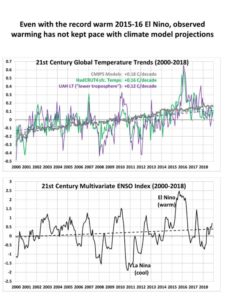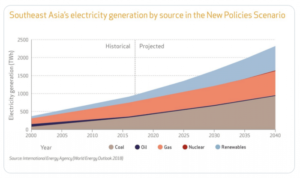by Roy Spencer, May 13, 2019 in GlobalWarming
A major uncertainty in figuring out how much of recent warming has been human-caused is knowing how much nature has caused. The IPCC is quite sure that nature is responsible for less than half of the warming since the mid-1900s, but politicians, activists, and various green energy pundits go even further, behaving as if warming is 100% human-caused.
The fact is we really don’t understand the causes of natural climate change on the time scale of an individual lifetime, although theories abound. For example, there is plenty of evidence that the Little Ice Age was real, and so some of the warming over the last 150 years (especially prior to 1940) was natural — but how much?
The answer makes as huge difference to energy policy. If global warming is only 50% as large as is predicted by the IPCC (which would make it only 20% of the problem portrayed by the media and politicians), then the immense cost of renewable energy can be avoided until we have new cost-competitive energy technologies.
The recently published paper Recent Global Warming as Confirmed by AIRSused 15 years of infrared satellite data to obtain a rather strong global surface warming trend of +0.24 C/decade. Objections have been made to that study by me (e.g. here) and others, not the least of which is the fact that the 2003-2017 period addressed had a record warm El Nino near the end (2015-16), which means the computed warming trend over that period is not entirely human-caused warming.
If we look at the warming over the 19-year period 2000-2018, we see the record El Nino event during 2015-16 (all monthly anomalies are relative to the 2001-2017 average seasonal cycle):
…

…
by E. W. Wolf, November 4, 2019 in WUWT
From Nature
An analysis of air up to 2 million years old, trapped in Antarctic ice, shows that a major shift in the periodicity of glacial cycles was probably not caused by a long-term decline in atmospheric levels of carbon dioxide.
During the past 2.6 million years, Earth’s climate has alternated between warm periods known as interglacials, when conditions were similar to those of today, and cold glacials, when ice sheets spread across North America and northern Europe. Before about 1 million years ago, the warm periods recurred every 40,000 years, but after that, the return period lengthened to an average of about 100,000 years. It has often been suggested that a decline in the atmospheric concentration of carbon dioxide was responsible for this fundamental change. Writing in Nature, Yan et al.1 report the first direct measurements of atmospheric CO2 concentrations from more than 1 million years ago. Their data show that, although CO2levels during glacials stayed well above the lows that occurred during the deep glacials of the past 800,000 years, the maximum CO2 concentrations during interglacials did not decline. The explanation for the change must therefore lie elsewhere.
Understanding what caused the shift in periodicity, known as the mid-Pleistocene transition (MPT), is one of the great challenges of palaeoclimate science. The 40,000-year periodicity that dominated until about 1 million years ago is easily explained, because the tilt of Earth’s spin axis relative to its orbit around the Sun varies between 22.1° and 24.5° with the same period. In other words, before the MPT, low tilts led to cooler summers that promoted the growth and preservation of ice sheets.
But after the MPT, glacial cycles lasted for two to three tilt cycles. Because the pattern of variation in Earth’s orbit and tilt remained unchanged, this implies that the energy needed to lose ice sheets2 had increased. One prominent explanation3 is that atmospheric levels of CO2 were declining, and eventually crossed a threshold value below which the net cooling effect of the decline allowed ice sheets to persist and grow larger.
…
by Charles the moderator, November 1, 2019 in WUWT
There’s just no stopping coal in Southeast Asia. Surging investments in wind and solar energy won’t be enough to shake the fuel’s dominance in the region for decades to come, according to the International Energy Agency.
Coal demand is expected to double to almost 400 million tons a year by 2040, the agency said in its Southeast Asia Energy Outlook published Wednesday. That’s 2.5% higher than its forecast from two years ago, even as renewable power capacity is seen more than tripling through 2040.
“Coal is rather resistant because it is affordable,” said Keisuke Sadamori, IEA’s director for energy markets and security. “It’s really hard for Southeast Asian countries to move away from affordable coal immediately.”

…
by K. Rodriguez, November 1, 2019 in ClimateChangeDispatch
A storm that made many areas of the Midwest feel more like winter than fall shattered a 96-year-old winter weather record in Chicago.
The historic storm system— which brought snow and cold over the Colorado Rockies this week— made it to the Midwest on Thursday morning, unleashing moderate-to-heavy snowfall in northeastern Kansas, eastern Iowa, Illinois, and southern Wisconsin.
The total accumulation expected in these areas is 3 to 5 inches of snow.
Chicago experienced its earliest snow day of the year where an inch or more of snow fell since October 20, 1989, and smashed its previous record of 0.7 inches at Chicago O’Hare International Airport on Wednesday with a whopping 1.2 inches of snow.
…
by Dr K. Kemm, November 1, 2019 in ClimateChangeDispatch
This month marks the tenth anniversary of “Climategate” – the release of thousands of emails to and from climate scientists who had been (and still are) collaborating and colluding to create a man-made climate crisis that exists in their minds and computer models, but not in the real world.
The scandal should have ended climate catastrophism.
Instead, it was studiously buried by politicians, scientists, activists and crony capitalists, who will rake in trillions of dollarsfrom the exaggerations and fakery, while exempting themselves from the damage they are inflicting on everyday families.
Few people know the Inconvenient Facts about the supposed man-made climate and extreme weather “crisis.”
For example, since 1998, average global temperatures have risen by a mere few hundredths of a degree. (For a time, they even declined slightly.)
Yet all we hear is baseless rhetoric about man-made carbon dioxide causing global warming and climate changes that pose existential threats to humanity, wildlife, and the planet.
Based on this, we are told we must stop using fossil fuels to power economic growth and better living standards. This is bad news for Africa and the world.
We keep hearing that rising atmospheric carbon dioxide levels cause rising global temperatures.
But satellite data show no such thing. In fact, computer model predictions for 2019 are almost a half-degree Celsius (0.9 degrees F) above actual satellite measurements.
…
…
See also here
La géologie, une science plus que passionnante … et diverse



